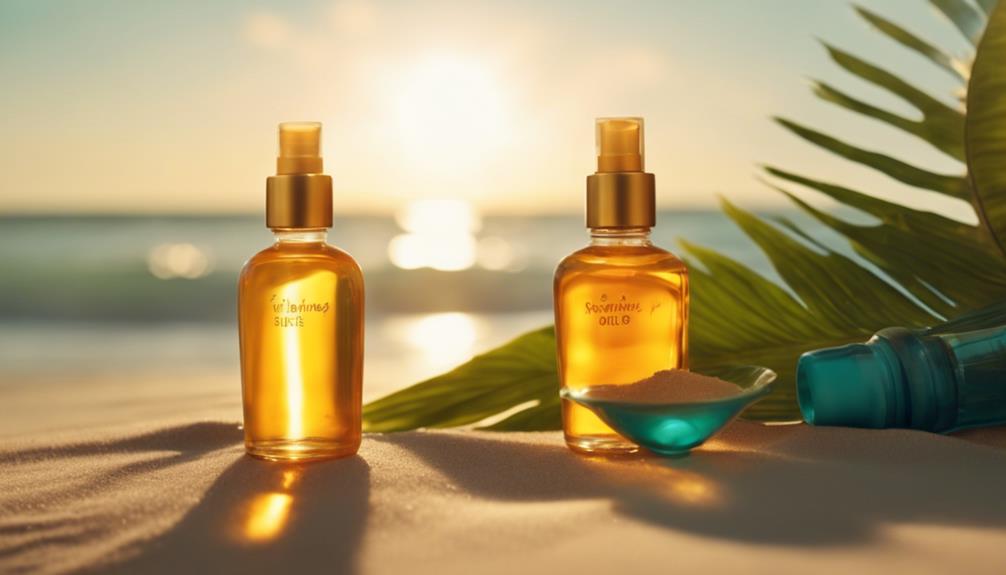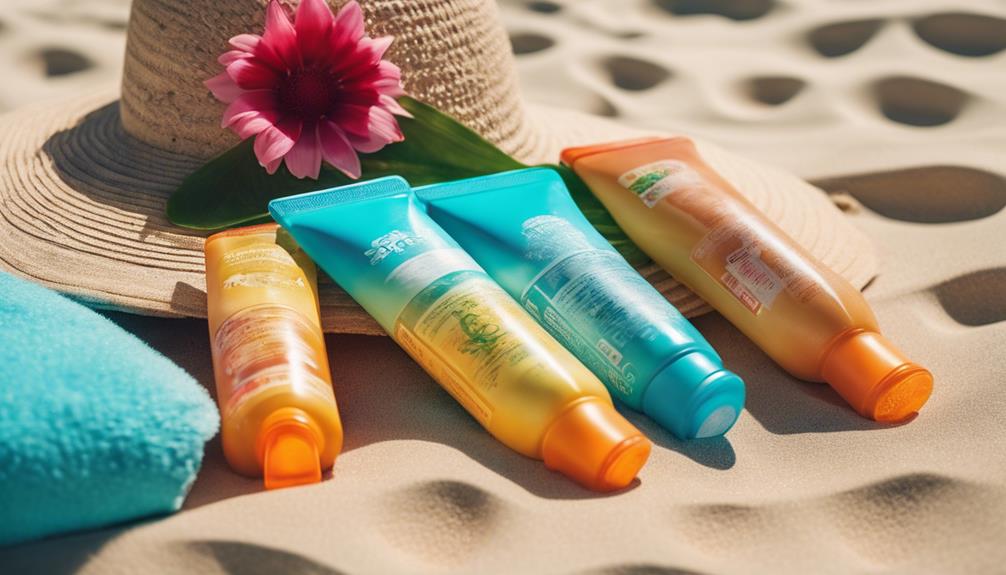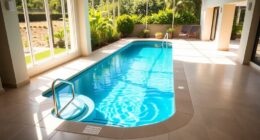For a safe and glowing tan, make sure to use a sunscreen with a minimum of SPF 30 to shield your skin from harmful UVB rays. Choose formulas that are broad-spectrum to protect against both UVA and UVB rays. Ingredients like coconut oil, aloe vera, and Vitamin E not only keep your skin moisturized but also help enhance your tan. Apply about one ounce of sunscreen for complete coverage and remember to reapply every two hours, especially after swimming or sweating. Opt for brands that are reef-safe to ensure you are protecting marine life. If you want to explore more top products that offer both glow and protection, there are plenty to discover!
Key Takeaways
- Choose broad-spectrum sunscreens with at least SPF 30 to protect against both UVA and UVB rays.
- Look for hydrating ingredients like coconut oil and aloe vera for nourishment while tanning.
- Opt for reef-safe products to protect marine life and choose those free from harmful chemicals.
- Ensure proper application by using about one ounce for full-body coverage and reapplying every two hours.
Importance of SPF
Choosing a sunscreen with at least SPF 30 is essential for protecting your skin from harmful UVB rays while you tan. SPF measures how well the sunscreen blocks UVB rays, with SPF 30 blocking about 97%. This level of protection is vital if you want to enjoy the sun without risking burns.
Remember, higher SPF values offer slightly better protection, but it's important to know that no sunscreen guarantees you won't burn. Regular reapplication is key; apply every two hours or immediately after swimming or sweating.
UVA Vs. UVB Rays
Understanding the differences between UVA and UVB rays is essential for effective sun protection and maintaining healthy skin while tanning.
UVA rays penetrate deeper into the skin, leading to premature aging and DNA damage. In contrast, UVB rays primarily cause sunburn and greatly contribute to skin cancer risk.
Both types are harmful, so it's vital to use a broad-spectrum sunscreen that protects against both. When choosing a tanning product, look for one that specifically mentions protection from UVA and UVB rays.
This way, you can enjoy your tanning experience without compromising your skin's health. Remember, consistent application is key to safeguarding your skin from these harmful rays while achieving that sun-kissed glow.
Key Ingredients in Formulas

To protect your skin effectively while tanning, it's important to pay attention to the key ingredients in sunscreen formulas that nourish and hydrate your skin.
Look for products that contain beneficial components to maximize your tanning experience.
- Coconut Oil: Provides deep hydration and helps achieve that golden glow.
- Aloe Vera: Soothes your skin, reducing inflammation and keeping it soft.
Application Techniques
Applying sunscreen correctly is essential for maximizing protection and achieving a beautiful tan, so make certain to use enough product and follow the right techniques.
Start by applying a generous amount—about one ounce—for full-body coverage at least 15 minutes before sun exposure.
When applying to your face, use your hands to guarantee even coverage and avoid spraying directly.
Don't forget hard-to-reach areas like your back and the tops of your ears.
Reapply sunscreen every two hours, or immediately after swimming or sweating.
Always check the product instructions for specific reapplication guidelines.
Staying consistent with these techniques will help you enjoy the sun safely while keeping your skin healthy and glowing.
Tanning Oils Benefits

Tanning oils not only enhance the tanning process but also nourish and hydrate your skin for a soft, luminous glow. These oils often contain beneficial ingredients that promote healthy skin while you soak up the sun. Plus, their lightweight formulas make application a breeze, ensuring an enjoyable tanning experience.
- Nourishment: Ingredients like coconut oil and aloe vera provide hydration, leaving your skin feeling soft and supple.
- Water Resistance: Many tanning oils offer water resistance, so you can enjoy swimming without losing protection.
With the right tanning oil, you can achieve that sun-kissed look while keeping your skin healthy and nourished.
Environmental Awareness
Environmental awareness is vital when choosing sunscreens, as many consumers seek reef-safe options that protect marine life from harmful chemicals.
You should look for sunscreens free of oxybenzone and octinoxate, which are known to damage coral reefs. By opting for eco-friendly products, you're not only safeguarding your skin but also contributing to the preservation of delicate ecosystems.
Many brands are now focusing on sustainable practices, using biodegradable packaging and natural ingredients. It's important to read labels and choose cruelty-free options too.
As awareness grows, your choices can reflect your environmental values, promoting healthier oceans and a more sustainable planet.
Consumer Trends

As consumers become more environmentally conscious, they're increasingly seeking sunscreens that align with their values, including vegan, cruelty-free, and reef-safe options. This shift in preference reflects a broader trend towards sustainable beauty products, where ethics meet efficacy.
You're likely to notice:
- A growing demand for lightweight, non-greasy formulas that enhance comfort during wear.
- An interest in multi-functional products that provide both hydration and sun protection.
These trends signal a significant change in how you choose sunscreen, emphasizing the need for transparency and responsibility in your tanning products.
Your choices not only protect your skin but also contribute to a healthier planet.
Recommended Products
You'll find a variety of recommended tanning sunscreens that not only protect your skin but also enhance your tanning experience. Here are some top picks to evaluate:
| Product Name | SPF |
|---|---|
| Australian Gold SPF 30 Spray Gel Sunscreen | SPF 30 |
| Sun Bum SPF 15 Moisturizing Tanning Oil | SPF 15 |
| Hawaiian Tropic SPF 15 Protective Tanning Oil Spray | SPF 15 |
These options balance hydration and protection, ensuring you achieve that coveted glow while keeping your skin safe. Remember to apply generously and reapply every two hours for the best results. With these products, you can enjoy the sun confidently!
Are the Top Tanning Sunscreens Also Effective for Tanning Bed Alternatives?
When it comes to finding the right sunscreen for tanning bed alternatives revealed, it’s important to choose a product that offers both protection and the ability to enhance your tan. Look for sunscreens with high SPF for protection, but also ingredients like melanin activators or bronzers to help boost your tan.
Conclusion
As you gear up for sunny days, remember that protecting your skin is just as important as achieving that radiant tan.
With the right tanning sunscreen, you can enjoy the sun's warmth without the worry of damage.
After all, who doesn't want to glow beautifully while keeping their skin healthy?
By choosing wisely and applying correctly, you can revel in your sun-kissed look and embrace the season with confidence.
Stay safe and shine bright!










